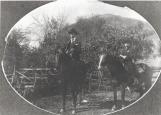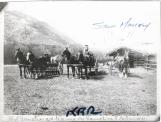1
Two men in the corral preparing to brand a calf1890-1910
Similkameen Valley, British Columbia, Canada
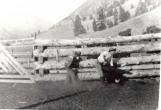 Credits:
Credits:From the Barcelo collection
2
Lukie & Manny Barcelo working cows in the big corralSimilkameen Valley, British Columbia, Canada
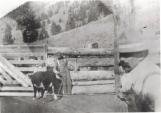 Credits:
Credits:From the Joe Bromley collection
3
Originally from Guymas, Mexico, Emanuel Barcelo had been in British Columbia some time before he arrived in the Similkameen. Having driven a herd of cattle to the Cariboo to meet the demand for beef created by the gold rush, he remained in the area working for the Hudson Bay Company. In his travels as a packer he stopped at Huntersville, near Hope, where he met the daughter of Henry Hunter. Lucy was 18 and Barcelo 45 when they married in 1879.In the same year, he took up a pre-emption on land in what is now Cawston, and, returning to Mexico, trailed a herd of cattle back. The valley was well suited to ranching - although it was dry, the hills were covered with bunchgrass and the river provided a source of water.
4
Working with horses in a big pole corral1890-1910
Similkameen Valley, British Columbia, Canada
 Credits:
Credits:From the Barcelo collection
5
Manny Barcelo, Manuel Barcelo's son, on his horse1905
Similkameen Valley, British Columbia, Canada
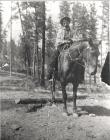
6
There were many similarities between F.X. Richter and Manuel Barcelo. Both worked as packers for the H.B.C., both were early settlers, amassing thousands of acres in their respective ranches and, like Richter, Barcelo branched out into several different areas. Barcelo had the first mill in the vicinity, although it was a relatively small one, compared to the later Barrington Price grist mill; he also built the Barcelo Hotel in Keremeos, which was managed by some one else, however, as Barcelo focused mainly on ranching.His ranch became known for the fine quality of the horses that were raised there. After Barcelo's death in 1913, his eldest son Manny took over the ranch, but was not able to maintain the vast acreage that his father had held. Piece by piece the land was sold: to W.H. Armstrong, to George Christie, and to others.
8
Looking northeast from the flats past Keremeos to the PincushionKeremeos, Similkameen Valley, British Columbia, Canada

9
Another large ranch in the area was owned by the Daly family. Elizabeth Daly came over the trail from Hope with her husband Thomas in 1885. When they arrived, he took her to the Hudson's Bay Post, which was part of the property, and said, "Well, here we are!"Mrs. Daly was shocked and disappointed with what she saw. "It was so dry, so hot, and nothing but a wilderness of wild sunflowers that my heart sank."
Fortunately, Tom Daly was just teasing his wife, as he drove on to "The Willows," the real house, complete with verandah and gardens.
It seems that at one time there was a sizable collection of snakes in a den under the house. These snakes would crawl up into the farm machinery, clogging the equipment. The children used to try to kill snakes by hitting them on the head with a hammer. This dangerous game was rarely successful, as the snakes were usually too fast. Surprisingly, none of the children were ever bitten.
10
Irrigation ditch with a Russell fence in the backgroundSimilkameen Valley, British Columbia, Canada
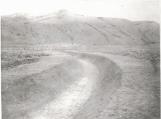
11
Daly Ranch held the first post office in the area, before George Kirby was post master; consequently the Daly family was well known in the community. They hosted many social events, music and drama and dancing. They also influenced other ranchers with innovative ideas: they were the first to clear land and plant alfalfa as a crop, and had an irrigation ditch dug.13
Riding home after delivering cattle for the Daly Ranch12 June 1914
Hedley, Similkameen Valley, British Columbia, Canada
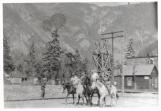 Credits:
Credits:From the collection of "Bill" Gibson (Lillian Estabrooks)
